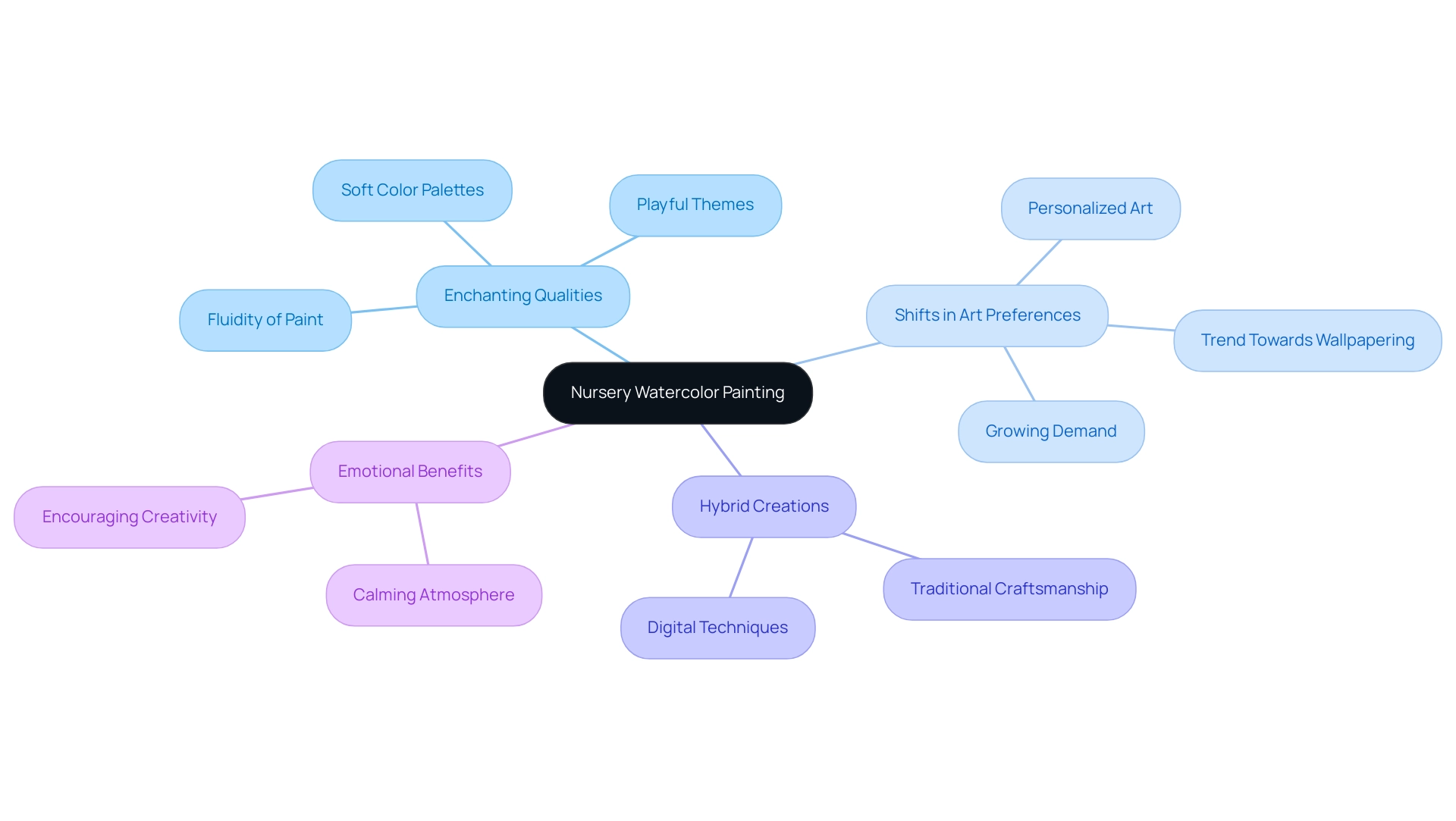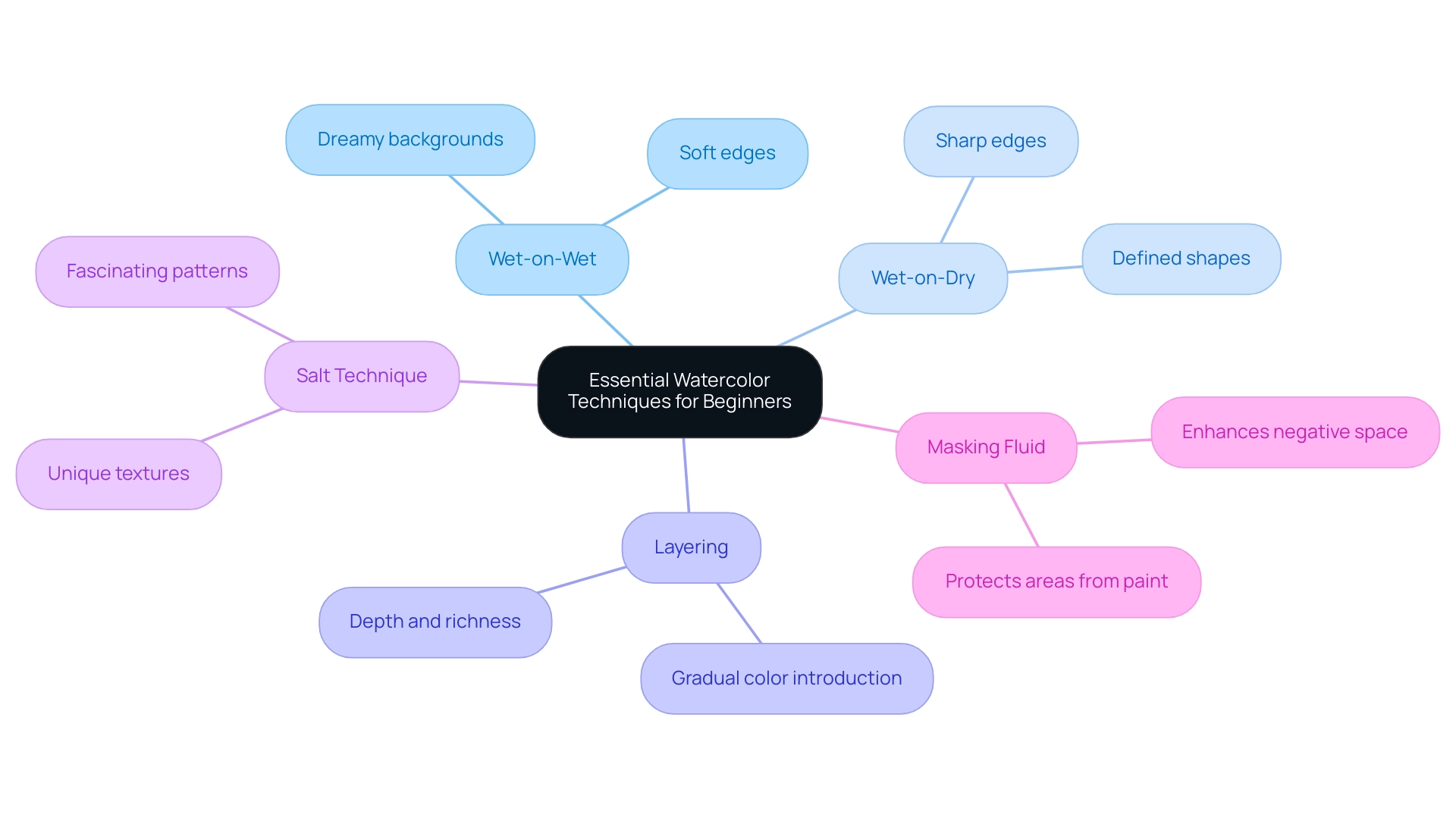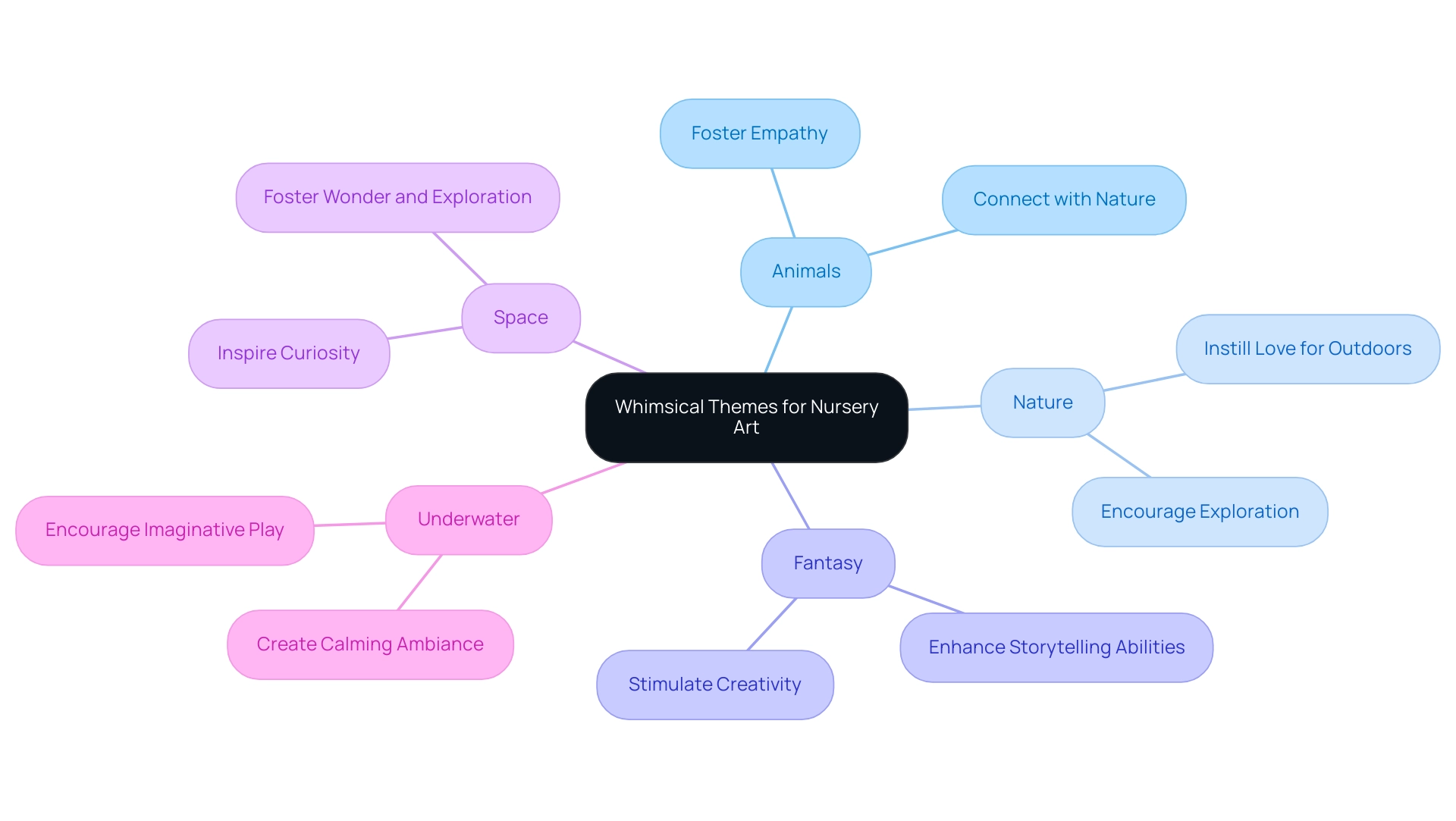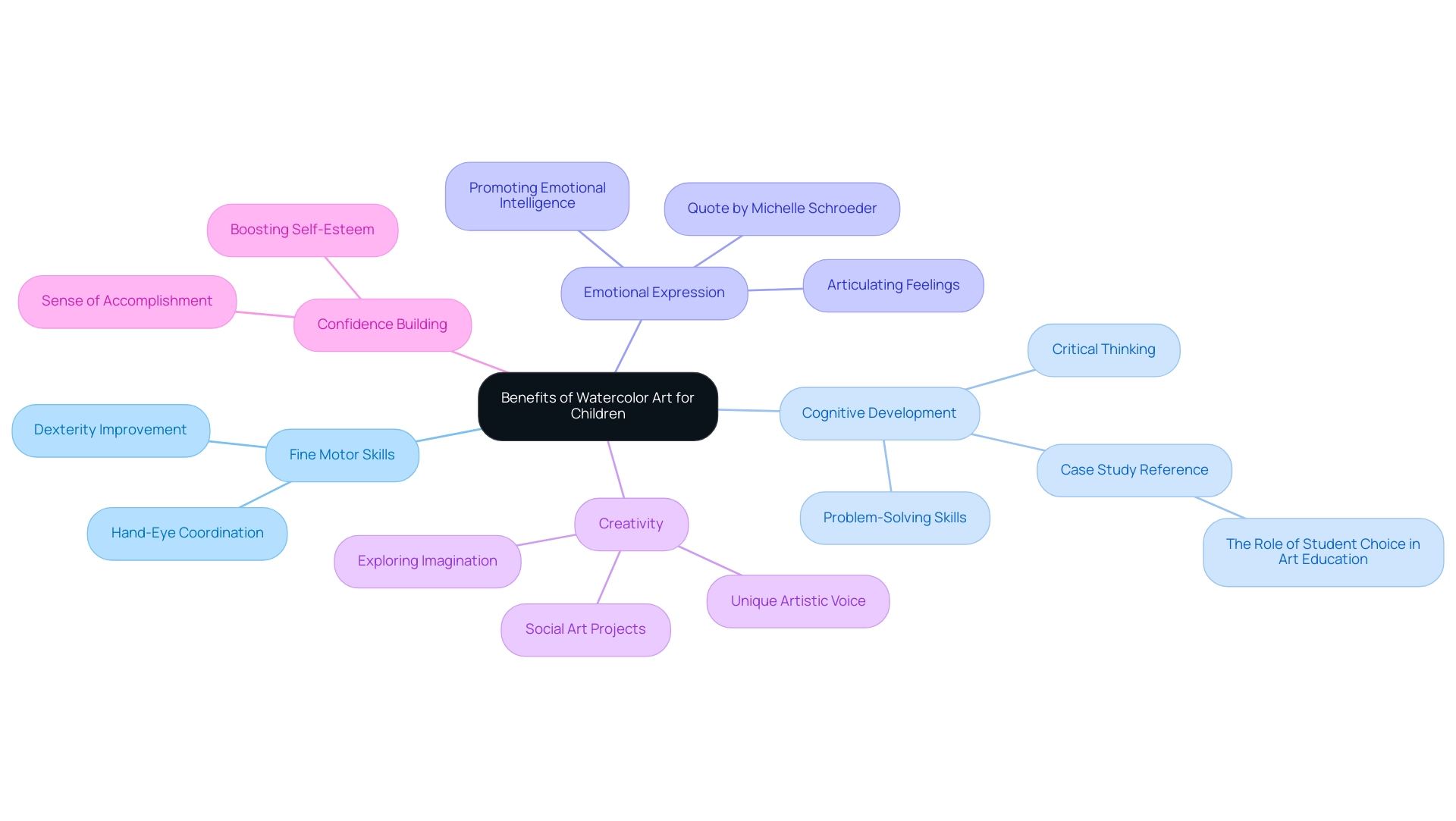Overview
This article delves into the enchanting world of nursery watercolor painting, showcasing the various techniques and themes that make it a vital tool for nurturing creativity and emotional growth in children.
Have you ever considered how art can transform a child’s space? By incorporating whimsical themes and personal touches into artwork, not only do we enhance the aesthetic appeal of children’s environments, but we also cultivate imaginative play and forge emotional connections.
Trends indicate a growing demand for such art forms in 2025, reflecting a heartfelt desire among parents to create nurturing spaces for their little ones. It’s a beautiful way to support their development while adding charm to your home.
Introduction
In a world where creativity meets nurturing, nursery watercolor painting emerges as a delightful art form that transforms children’s spaces into imaginative realms. Have you ever dreamed of creating a magical haven for your little one? This enchanting style, characterized by its soft color palettes and whimsical themes, not only captivates young minds but also fosters a serene environment conducive to growth and exploration.
As parents increasingly seek personalized and vibrant decor that reflects their child’s personality, the demand for unique watercolor art has surged, blending traditional techniques with modern trends. Moreover, this article delves into the captivating world of nursery watercolor painting, exploring:
- Essential techniques
- Whimsical themes
- The profound impact of personalization on children’s emotional development
Discover how this art form can inspire creativity and warmth in a nursery, creating a nurturing space for little ones to thrive.
Exploring the World of Nursery Watercolor Painting
Nursery watercolor painting is an enchanting art form that specializes in crafting whimsical and soothing imagery designed for young ones’ spaces. This delightful style typically features soft color palettes, playful themes, and gentle designs that can ignite a young person’s imagination while fostering a serene atmosphere. The unique fluidity of this paint enables seamless color blending, making it an ideal medium for illustrating dreamy landscapes, adorable animals, and captivating scenes that can transform a child’s room into a magical haven.
As parents increasingly prioritize nurturing settings for their offspring, have you noticed the growing demand for watercolor art tailored for young ones? In 2025, statistics reveal a notable shift in children’s art preferences, with a growing inclination towards vibrant, customizable pieces that reflect their personalities. This trend aligns beautifully with the broader movement in home decor, where fully wallpapering children’s rooms is becoming more popular than traditional accent walls.
This shift creates immersive environments that resonate with young imaginations, enhancing the overall aesthetic and emotional appeal of the space.
Present trends in children’s art emphasize the significance of hybrid creations that blend traditional craftsmanship with digital methods, expanding the limits of artistic expression. Artists like Kelly Swain, who specializes in custom watercolor illustrations and surface pattern design inspired by her life in Vienna, highlight the benefits of incorporating personalized art into children’s spaces. Her unique designs not only enhance the aesthetic appeal but also contribute to emotional well-being by creating a calming and inviting atmosphere.
Kelly Swain provides a range of giclee fine art prints in various sizes and price ranges, simplifying the process for parents to discover the ideal piece for their child’s room. As Gold notes, “Additionally, the caning on both the crib and the dresser adds to the casual feeling of the collection while elevating the design and adding visual interest,” which underscores the importance of thoughtful design elements in children’s spaces.
Moreover, case studies from ‘Top Wall Art Trends in 2025’ demonstrate how successful children’s art projects have transformed spaces, showcasing the versatility and impact of large canvas wall art as a focal point. This approach not only reflects the homeowner’s personality but also serves as a source of inspiration for young ones, encouraging creativity and exploration in their formative years. Ultimately, the importance of painting art in children’s areas cannot be overstated, as it plays a crucial role in nurturing creativity and warmth within the playroom.

Essential Watercolor Techniques for Beginners
For those embarking on the journey of watercolor painting, mastering a few fundamental techniques can significantly enhance the creation of beautiful artwork. Have you ever felt uncertain about where to start? Here are some essential methods to explore:
-
Wet-on-Wet: This technique involves applying wet paint onto wet paper, allowing colors to blend seamlessly. The result is soft edges and ethereal effects, ideal for creating dreamy backgrounds or gentle landscapes in children’s art.
-
Wet-on-Dry: In contrast, this method applies wet paint to dry paper, producing sharper edges and more defined shapes. This technique is perfect for adding intricate details, such as animals or playful elements, that capture a child’s imagination.
-
Layering: Building up layers of color is crucial for adding depth and richness to your artwork. Begin with lighter washes and gradually introduce darker tones, allowing each layer to dry before adding the next. This approach creates a vibrant and dynamic piece that can engage young viewers.
-
Salt Technique: By sprinkling salt onto wet paint, you can create unique textures as the salt absorbs moisture and pigment, leaving behind fascinating patterns. This technique can add an element of surprise and whimsy to your nursery watercolor painting, making it visually captivating.
-
Masking Fluid: This tool is invaluable for protecting specific areas of the paper from paint, enabling the creation of highlights or intricate designs. It allows artists to experiment with negative space, enhancing the overall composition of the artwork.
Moreover, it’s essential for beginners to understand how to care for their painting supplies. Store paint in a cool, dry location away from direct sunlight, and keep tubes tightly closed to prevent them from drying out. As Kelly Swain advises, “Store paint in a cool, dry location away from direct sunlight.”
Following these best practices ensures that your supplies remain usable over time, allowing you to focus on your creativity.
By mastering these techniques and taking care of your materials, beginners can not only experiment with their creativity but also develop a personal style in nursery watercolor painting. This makes the process of creating art for children both enjoyable and rewarding.

Choosing Whimsical Themes for Nursery Art
When selecting themes for nursery watercolor painting, it’s important to choose those that ignite a young one’s imagination and foster a sense of wonder. Have you ever thought about how the right theme can spark creativity? In 2025, several whimsical themes stand out:
- Animals: Adorable creatures such as elephants, giraffes, and bunnies not only create a playful atmosphere but also help children connect with nature and develop empathy.
- Nature: Illustrations featuring trees, flowers, and serene landscapes can instill a love for the outdoors, encouraging young ones to explore their environment.
- Fantasy: Themes that include fairies, unicorns, and magical forests transport young ones to enchanting worlds, stimulating their creativity and storytelling abilities.
- Space: Depictions of stars, planets, and rockets inspire curiosity about the universe, fostering a sense of wonder and exploration.
- Underwater: Vibrant scenes with colorful fish, mermaids, and coral reefs create a calming underwater ambiance, perfect for relaxation and imaginative play.
These themes not only enhance the visual charm of a child’s room but also play a vital role in encouraging storytelling and imaginative play, especially with nursery watercolor painting. According to recent statistics, young individuals gravitate towards art that reflects their interests, with animals and fantasy themes being among the most favored. As Ricky, a consultant for promoting positive learning environments, states, “Wall Art is a wonderful resource for schools to create positive learning environments. We tailor designs to each school’s unique objectives.” This sentiment applies equally to early childhood art, particularly nursery watercolor painting, where whimsical elements significantly contribute to a young one’s emotional and cognitive development.
Moreover, the changing trends in literature for young audiences, such as interactive storytelling, emphasize the significance of captivating themes in early art. By creating a nurturing environment filled with imaginative themes, parents can foster creativity and a love for art from an early age through nursery watercolor painting. Ongoing communication throughout the illustration process is essential for parents considering custom artwork, ensuring that the final pieces resonate with their child’s interests and developmental needs.

Gathering Supplies: What You Need for Nursery Watercolor Painting
Embarking on your nursery watercolor painting journey can feel overwhelming, but selecting the right supplies can truly enhance your creative experience. Here are some essentials to consider:
- Watercolor Paints: Opt for a high-quality set of watercolor paints, available in either tubes or pans, that provides a diverse palette of colors. This variety allows for greater creativity and expression in your artwork.
- Painting Paper: Invest in thick, textured painting paper specifically designed to withstand moisture. This type of paper minimizes warping and enhances paint absorption, ensuring your artwork maintains its integrity.
- Brushes: A range of brushes in various sizes is crucial for achieving different effects. Look for soft, synthetic brushes that retain water well, as they facilitate smooth application and blending.
- Palette: A mixing palette is indispensable for blending colors and crafting custom shades, enabling you to experiment with your artistic vision.
- Water Container: Keep a jar of clean water nearby for rinsing brushes and diluting paint. This simple tool is vital for maintaining the quality of your work.
- Paper Towels: These are essential for blotting excess water or paint and for cleaning brushes, ensuring a tidy workspace.
- Masking Tape: Use masking tape to secure your paper and create clean edges, which can enhance the overall presentation of your artwork.
Moreover, consider participating in the Improvers course in June 2025, which costs £125, to further enhance your painting skills. Engaging with local art events can also be beneficial. As illustrator Rosalie Haizlett suggests, have you thought about joining us for the free opening reception at 5pm, followed by a free book talk and signing in fine arts room 209 at 6pm?
For product suggestions, Dick Blick’s Premier paint blocks are recognized for their quality and price advantage, making them an excellent option for beginners. Remember, as highlighted in the case study titled “Final Tips for Beginners,” starting with quality materials and tracking your progress can significantly impact your artistic journey. Equipping yourself with these supplies not only makes your nursery watercolor painting sessions more enjoyable but also fosters a nurturing environment for creativity, empowering you to express your unique vision in your decor.

The Power of Personalization in Nursery Watercolor Art
Personalization in nursery watercolor painting plays a crucial role in strengthening the emotional bond between the artwork and your little one. Custom designs can encompass various elements that resonate deeply with young individuals, including:
- Name Art: Integrating your child’s name into the artwork instills a sense of ownership and belonging, vital for their emotional development.
- Family Portraits: Whimsical illustrations of family members nurture feelings of love and togetherness, reinforcing your child’s sense of security.
- Milestone Art: Pieces that commemorate significant moments, such as birthdays or first steps, serve as cherished keepsakes, helping your child connect with their personal history.
- Favorite Characters: Incorporating beloved storybook characters or themes that resonate with your child enhances relatability and engagement, making the art more meaningful.
Research indicates that personalized art can significantly impact development, with psychologists emphasizing its importance in fostering emotional well-being. In fact, 73% of customers anticipate personalization to enhance with technology, reflecting a growing trend towards tailored experiences in art for younger audiences. Moreover, customers are willing to spend 38% more with brands that personalize effectively, highlighting the financial value of investing in personalized nursery art.
As parents invest in nursery watercolor painting, you not only create a unique environment that reflects your child’s personality but also contribute to their emotional growth and security. This approach aligns with recent findings showing that almost 60% of businesses experience increased retention and conversions through personalization strategies, underscoring the value of custom designs in nurturing creativity and emotional connections. Additionally, 56% of online customers are more likely to return to websites offering product recommendations, indicating the broader implications of personalization in art.
A satisfied customer shared their experience after purchasing a custom painting as a housewarming gift, stating it was ‘the perfect housewarming gift.’ This illustrates the emotional resonance and cherished moments that personalized art can create. With prices starting at $15.00, investing in personalized nursery art not only enhances your child’s environment but also provides a meaningful connection that lasts a lifetime.

Fostering Creativity and Development Through Watercolor Art
Engaging in watercolor painting offers a multitude of developmental benefits for children, making it an invaluable activity for nurturing their growth. Have you ever considered how such creative pursuits can shape a child’s future?
- Fine Motor Skills: The act of manipulating brushes and paints significantly enhances hand-eye coordination and dexterity, essential skills for various daily tasks.
- Cognitive Development: Art fosters critical thinking and problem-solving abilities as individuals navigate decisions regarding colors, shapes, and compositions, encouraging a deeper understanding of their environment. Research indicates that permitting young individuals to make choices in their artistic endeavors, as highlighted in the case study “The Role of Student Choice in Art Education,” fosters individual expression and creativity.
- Emotional Expression: Painting serves as a safe outlet for young individuals to articulate their feelings, promoting emotional intelligence and resilience. This creative expression can be particularly beneficial in assisting young people in processing complex emotions. As Michelle Schroeder, President of the New York State Art Teachers Association, notes, “In so much of their careers and their future, people are either going to criticize or they’re going to suggest improvements, and our students need to become comfortable with receiving feedback from other people.”
- Creativity: The freedom inherent in creating art allows individuals to explore their imagination, cultivating their unique artistic voice and encouraging innovative thinking. Preschoolers particularly enjoy social art projects and storytelling, which enhances their engagement with art and fosters social skills.
- Confidence Building: Completing a painting instills a sense of accomplishment, significantly boosting a young person’s self-esteem and confidence in their abilities.
Moreover, studies show that youngsters who participate in artistic education, such as nursery watercolor painting, exhibit enhanced academic results, including better grades and graduation rates. Furthermore, studies show that socially and economically disadvantaged youth benefit immensely from arts education, highlighting its role in leveling the playing field.
By incorporating nursery watercolor painting into their routines, parents can not only support their children’s holistic development but also foster a lifelong passion for creativity, which sets the foundation for future success in various aspects of life. Isn’t it heartwarming to think about the lasting impact such simple activities can have?

Conclusion
Creating a nursery adorned with watercolor art goes beyond mere aesthetics; it nurtures an enriching environment that fosters creativity and emotional growth in children. As we explore the world of nursery watercolor painting, we highlight essential techniques, whimsical themes, and the profound impact of personalization as key components in crafting a magical space for young ones.
Have you ever considered how techniques like wet-on-wet and layering can empower both parents and budding artists? These methods allow for the creation of captivating pieces that truly resonate with children. By choosing themes that ignite imagination—such as animals, fantasy, and nature—art can transform a nursery into a vibrant realm that encourages storytelling and exploration. Moreover, the importance of personalization cannot be overstated; integrating elements like name art and family portraits fosters a sense of belonging and emotional security, essential for a child’s development.
Ultimately, nursery watercolor art serves as a powerful tool to inspire creativity, enhance emotional well-being, and create lasting memories. By investing in this enchanting art form, parents not only beautify their child’s space but also contribute significantly to their emotional and cognitive development. Embracing the world of nursery watercolor painting opens doors to imaginative adventures, making it a truly worthwhile endeavor for both children and parents alike.
Frequently Asked Questions
What is nursery watercolor painting?
Nursery watercolor painting is an art form that creates whimsical and soothing imagery designed for children’s spaces, featuring soft color palettes and playful themes that inspire imagination and foster a serene atmosphere.
What are the current trends in children’s art preferences?
In 2025, there is a growing inclination towards vibrant, customizable pieces that reflect children’s personalities, with a trend towards fully wallpapering children’s rooms rather than using traditional accent walls.
How does nursery watercolor painting contribute to children’s environments?
It helps create immersive environments that resonate with young imaginations, enhancing both the aesthetic and emotional appeal of a child’s space.
What is the significance of hybrid creations in children’s art?
Hybrid creations blend traditional craftsmanship with digital methods, expanding artistic expression and allowing for more personalized art in children’s spaces.
Who is Kelly Swain, and what does she offer?
Kelly Swain is an artist who specializes in custom watercolor illustrations and surface pattern design. She offers a range of giclee fine art prints in various sizes and price ranges for children’s rooms.
What role does thoughtful design play in children’s spaces?
Thoughtful design elements, such as caning on furniture, contribute to the overall aesthetic and emotional comfort of children’s spaces, making them more inviting.
How can large canvas wall art impact a child’s space?
Large canvas wall art serves as a focal point, reflecting the homeowner’s personality and inspiring creativity and exploration in children.
What are some essential techniques for beginners in watercolor painting?
Key techniques include Wet-on-Wet, Wet-on-Dry, Layering, Salt Technique, and Masking Fluid, each offering different effects and enhancing creativity in nursery watercolor painting.
How should painting supplies be cared for?
Painting supplies should be stored in a cool, dry location away from direct sunlight, with tubes tightly closed to prevent drying out, ensuring they remain usable over time.
What is the overall importance of painting art in children’s areas?
Painting art in children’s spaces is crucial for nurturing creativity and warmth, contributing to a calming and inviting atmosphere in playrooms.
comments +